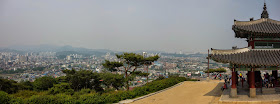The fortress and palace were built in 1794 by King Jeongjo to house and honor the remains of his father Prince Sado, who had been murdered by being locked alive inside a rice chest by his own father King Yeongjo after failing to obey the command to commit suicide.
I've been to Haenggung Palace before, but Jihyeon's Parents wanted to take me there again for a picnic lunch.
The palace gates.
Jihyeon's mother packed heaps of food.
The picnic area is is within the castle grounds so you need to buy entry tickets for around 2000won a pop ($2).
A large ancient prayer/wishing tree.
Cheese.
Get out of the photo kid.
The first time I visited the palace the weather was starting to warm up, but it was still fairly cool and spring was still a way off. This time was much more colourful.
We then left the palace...
and started climbing up the trail behind the palace to check out the view and start exploring the Hwaseong Fortress wall.
Half way up is a natural spring where you can get a cool refreshing drink.
If your legs are not up to the challenge of hiking around the perimeter of Hwaseong Fortress, there is this road train which takes you on a tour of the norther perimeter.
The route of the train is highlighted in pink on the map below.
We slowly made our way up the mountain.
Stopping to rest a couple of times as we went.
After checking out the view, we followed the fortress wall back down the northern side of the mountain.
One of the watch towers on the wall perimeter.
I really like how the wall literally snakes it's way through the city and Koreans go about their every day lives in the a stones through from this cool historical site.
Cheese.
Suwon Hwaseomun (Gate), built in 1796, somehow managed to survive the Japanese occupation and Korean war intact, leading it to be designated as National Treasure No. 403. A section of the stone wall on the left of the arched gate contains the names of the workers and the foreman who built it.
The kid dressed in yellow on his tricycle could not be happier. I've never seen such a big smile.
Police on patrol standing in the shade.
Janganmun (Gate), built in 1794, is one of the four main gates into Hwaseong Fortress. "Jangan" has the dual meaning of "capital city" and "welfare of the people". This gate features a semicircular reinforced defense position attached to its exterior. Unfortunately, the gate was partially destroyed during the Korean War but has since been restored.
To explore the fortress... you are supposed to buy a ticket. Oops. An adult ticket is 1000won ($1) a pop.
Right by Janganmun gate is a small convenience store. It was hot, so we decided to grab some ice cream and water before continuing on our journey.
Koreans navigate their way around the wall as part of their every day commute to and from work.
I was really interested to see Hwahongmun Gate (otherwise known as Buksumun). This gate was installed to allow the river to flow through the fortress, it seems to introduce a fairly serious weak point in the wall though. I really liked this area, so I ended up taking a crap load of photos. Enjoy.
It was then getting fairly late, so we found a bus and headed back to the in-laws for dinner and sleep.































































